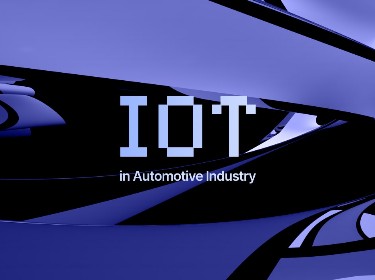The Internet of Things (IoT) acts as the fabric that connects machines with other machines and people. In manufacturing, IoT enhances the information flow and enables cloud-based AI analytics to optimize production facilities, decrease costs, and improve the safety of manufacturing environments.
Society has undergone three industrial revolutions to date: mechanization, electrification, and automation all changed the world forever. Today we stand at the brink of the fourth industrial revolution, one that will bring radical changes to the way we live and work. The transformation will have a profound effect on the manufacturing industry.
The fourth industrial revolution sees the latest digital technologies being used to improve manufacturing processes. Big data enhances real-time decision-making, while advanced analytics use the information to provide insights that increase production efficiency. Machine learning and other AI techniques increase efficiency across all factory and supply chain operations. 3D printing speeds up the time-to-market of many industrial products. Augmented reality allows inspection of virtual designs before committing to manufacturing — and it also offers a powerful tool to trained personnel by assisting during maintenance and fault diagnosis. Similarly, human-machine interfaces make human-robot collaboration easier.
Finally, we come to the Internet of Things. This technology provides channels of communication that transport data from machines to other machines, and from customers to business owners. Manufacturing IoT fuels the other digital technologies, from big data and advanced analytics to artificial intelligence. It enables truly data-driven decision-making in manufacturing.
Read on to find more about the role of IoT in manufacturing, its chief benefits, and applications Discover what companies are currently leveraging IoT and some future scenarios involving IoT in manufacturing.
Smart manufacturing and IoT
The Internet of Things, a term coined in 1999 by Kevin Ashton, refers to the collection of small yet powerful devices that can connect to the Internet and exchange data with other devices and people. The nodes in the IoT networks gather data from their environment either with the help of sensors or by communicating with other devices that have access to the target data. The data is communicated with Cloud services via Internet connectivity.
Data from IoT devices is augmented by other information and stored in the Cloud, where it is used to extract useful insights and improve business processes in any industry.
IoT is an integral part of the smart manufacturing concept. Smart manufacturing is characterized by a high level of adaptability and rapid design changes that are only possible with fully connected factories and supply chains. IoT solutions in manufacturing enable fast changes in production levels based on demand, efficient production, better material use, and optimization of the flow of goods and materials into and out of manufacturing environments. IoT solutions for manufacturing often hide behind terms such as industrial IoT, cyber-physical systems, industry 4.0, and smart factories.
Find out more about this web and mobile IoT solution for BMW dealer showroom services
IoT benefits for manufacturing
![]()
Interconnected and ubiquitous IoT devices are transforming many aspects of the manufacturing industry. The clearest benefits are cost reduction, better product quality, mass customization, improved safety, and increased process efficiency.
Cost reduction
IoT devices provide highly insightful information about the utilization of assets. This in turn leads to better asset management. Making sure assets are used optimally decreases the costs associated with their maintenance. One of the basic principles in management is that everything that can be measured can be managed. IoT technology is a powerful ally in this respect. IoT devices help factories and offices to optimize their energy use and reduce operational costs. At the same time, IoT is opening up new avenues for revenue generation by allowing companies to shift from product-based business models towards service-based ones.
Better product quality
The main objective of any process improvement initiative in manufacturing is to increase the quality of the product while decreasing the cost of production. Improvements in the quality of products can, unsurprisingly, have a profound impact on a manufacturing business. High-quality products can reduce waste, generate other products that are even better, increase customer satisfaction, and improve sales.
IoT plays a crucial role in increasing product quality. This is down to the fact that the most common reasons for deteriorated product quality are machine malfunction and the poor calibration/setup of the machine. Both of these phenomena are reflected in measurable machine signals such as temperature, vibration, and noise. Connected IoT devices can monitor these signals, and detect and report any anomaly or deviation from ideal working conditions. This close, consistent observation of machinery ensures that the desired product quality is achieved.
Mass customization
Mass customization, mass personalization or made-to-order are all terms used to describe situations when a mass-produced product is customized to fit customer demands. Studies have shown that more than 50% of customers are interested in acquiring personalized or custom products. Mass customization is a great economic driver for companies that are seeking to diversify their revenue streams.
The biggest barrier to mass customization is the cost. Current manufacturing systems are made for mass production. When, in contrast, a product is produced under a predetermined break-even quantity, the production becomes unprofitable. IoT is transforming manufacturing facilities into more flexible units that can routinely and profitably deal with customization. Traditionally, production had to be stopped to reprogram some parts of the production track so that it could handle the production of different lines. With the help of IoT, new settings and programs are applied automatically via the network. As a result, many different products can be manufactured at the same time without the need for stoppages. IoT solutions for manufacturing are turning a mass production system into a game of mass customization.
Improved safety
IoT improves workplace safety in many different respects. In manufacturing and other production facilities, workers are equipped with RFID tags that can be embedded in their clothes to monitor their location. Meanwhile, wearable devices collect data about their vital signs such as skin temperature, heart rate, and perspiration. Location and biological data collected from workers is sent to the Cloud where it is analyzed together with other data coming from their work environments such as noise, ambient temperature and humidity, air quality, motion, and light. Additional data about work planning and weather can be combined with this to detect any anomalies in the workers’ behavior. IoT in the manufacturing environment ensures a safer workspace by preventing high-risk activities that lead to injuries. Similarly, it addresses safety problems in hazardous environments. For example, IoT sensors are capable of detecting any gas leakages or steam outbursts.
By monitoring employee activity, IoT technology can be used as a preventive measure to warn against prolonged physical inactivity. Equally, it can ventilate workspaces to improve air quality.
Increased process efficiency
IoT supplies the necessary information for a better decision-making process. In manufacturing, IoT gathers crucial data about the performance of items of machinery on the factory floor and provides insightful information about equipment (mal)functioning. By using this data, managers and field technicians can follow necessary procedures to enhance the efficiency of the plant.
For many organizations, the manufacturing process is not monolithic. It is often distributed across multiple facilities. Thanks to its ubiquitous connectivity, IoT offers monitoring capabilities that enable companies to oversee the whole manufacturing operation in a unified manner, irrespective of the physical locations of the plants.
Check out how this IoT solution for water hauling process management has boosted efficiency and streamlined business processes
IoT applications in manufacturing
![]()
IoT has numerous applications in manufacturing. Some of the most prominent of these are predictive maintenance, remote monitoring and control, asset tracking and management, digital twins, connected operational intelligence, and logistics management.
Predictive maintenance
Maintenance of manufacturing equipment has traditionally been done in two ways: reactive or preventive. Reactive maintenance was carried out after the equipment had become defective. Preventive maintenance was done on a schedule based on the normal operating conditions or historical data provided by the manufacturer of the equipment. Both of these methods are potentially inaccurate: there is the risk that equipment will be over-maintained or, conversely, under-maintained. Predictive maintenance, however, mitigates the shortcomings of reactive and preventive maintenance by enabling just-in-time maintenance that leads to optimal utilization of equipment and lower maintenance costs.
Predictive maintenance makes use of IoT to collect data about the machine’s health and how it is used, while artificial intelligence algorithms analyze this data to predict when the equipment will fail given current operating conditions. Manufacturing equipment is monitored by connected sensors that send data to the Cloud where it is analyzed in order to detect anomalies and predict how much useful life remains. IoT in manufacturing enables more efficient maintenance operations and management of the equipment.
Remote monitoring and control
Remote monitoring and control have been possible in manufacturing since the 1990s via supervisory control and data acquisition (SCADA) systems. SCADA systems were built with large, stationary manufacturing facilities in mind. To make SCADA more agile and flexible in moving data to the remote servers, OPC-UA was introduced. OPC-UA, developed by OPC Foundation, is marketed as a machine-to-machine communication protocol for industrial automation. Nevertheless, many manufacturing companies still struggle with maintenance and lack of opportunities for expanding the SCADA and OPC-UA combination. As customers expect more and more efficient services, companies are seeking ways to stay agile, flexible, and cost-effective through the use of cloud-based remote monitoring and control solutions.
The Internet of Things in manufacturing offers many benefits over classic SCADA and OPC-UA systems. IoT increases the overall equipment effectiveness (OEE). This productivity model combines downtime, production rate, and quality. Thanks to connected sensors and cloud-based data analytics, achieving the desired OEE is more cost-effective and simpler to realize than ever before. IoT also makes the relevant information easily accessible to all employees involved in the overall efficiency of the manufacturing operation, such as line operators, maintenance crews, and production supervisors.
Asset tracking and management
Asset tracking or, more generally, asset management, is a process of tracking physical assets in the facility or throughout the supply chain to prevent their loss and to maintain their desired condition. Traditionally, asset management was performed manually by scanning barcodes and doing inventories. IoT allows for the streamlining of this process, and automates it. IoT asset tracking provides tools to bring about significant efficiency improvements.
An asset management system usually consists of a tiny and connected tracking device that is attached to the asset, or placed next to it. It proceeds to send data about the asset location and condition to the Cloud. IoT-based asset management solutions also provide a management platform from which the tracking devices are coordinated and where data analysis is performed.
The main business benefits of IoT-based asset management are increased efficiency due to automated and precise management, real-time information about the asset conditions in time-sensitive applications, automation of management and interconnection with supply chain systems, and recoverability of stolen or lost assets.
Digital twins
The cornerstones of Industry 4.0 and cyber-physical systems — digital twins — are the digital representations of real objects. They use the same data as real-world objects and produce results identical to those of a real-world object under the same conditions. This mimicking of behavior allows for extensive investigation of real-world objects in a simulated environment.
The twin and the real-world counterpart both receive data from the same sensors. In this way, the twins can simulate the physical objects in real-time and offer deep insights into their performance and possible malfunctioning.
In manufacturing, digital twins benefit from the acquisition, aggregation, and analysis of data from IoT devices. They open a way to the simulation of possible scenarios for predicting results in the virtual world without affecting real-world production. Thus digital twins save precious time and help predict problems before they occur in the physical process. Overall, digital twins increase process efficiency and product quality.
Connected operational intelligence
Operational Intelligence (OI) is real-time business analytics that provides insights into data and business operations. Connected OI, on the other hand, utilizes industrial IoT sensors to generate the data feeds from core business assets. In manufacturing, connected OI relies on the connected sensors that upload data to the Cloud, where it is analyzed to deliver results as operational instructions. Thanks to the IoT devices, connected OI allows enterprises to make decisions and act through predefined automated actions.
Logistics management
The IoT-led interconnection will be beneficial for companies that highly depend on transportation. The use of IoT-based devices can help manufacturers eliminate risks associated with the cost of vehicles and transportation by enabling them to monitor fuel costs, diagnostics, and repairs. Moreover, real-time data on vehicle and driver performance leads to increased technician safety and reduced inventory damage.
Take a look at Intel IoT app — an enterprise IoT mobile app and data gathering solution
Top companies leveraging IoT for manufacturing
![]()
Many companies are leveraging IoT for manufacturing. Industrial robots and equipment manufacturers such as ABB, Fanuc, Rockwell, and Hitachi stand out in this field. Here we’ll look at some of these leading players, which are all deploying IoT to deliver faster, better, and more cost-effective products and services to their customers.
ABB
ABB, a power and robotics company, is making an all-inclusive shift towards IoT in manufacturing. The company is using connected sensors to monitor the operation of their robots to predict their maintenance needs. With predictive maintenance solutions, ABB is capable of triggering just-in-time change of parts and other maintenance operations. Such efforts decrease the downtime of the robots and contribute to cost-savings and increased product quality. Additionally, the company is leveraging the concept of collaborative robotics to diversify its offerings. Their YuMi robot, which was designed to operate beside human workers, communicates with the external world through well-established industrial IoT protocols.
Airbus
Airbus is building the Factory of the Future packed with IoT, Cloud, and data analytics technologies. In its factories, Airbus is assembling commercial airplanes that have over a million components. To deal with this complexity while maintaining the process efficiency and driving the costs down, Airbus has equipped the factory with sensors to monitor every step of the assembly process. It has also equipped the employees with wearables to reduce workplace errors and increase safety.
Amazon
Amazon leverages Wi-Fi-connected Kiva robots for warehouse fulfillment. The company became interested in warehouse robots late in 2012 when it purchased Kiva Systems for $775 million. In 2021, the number of such robots reached 200k. The robots are controlled by a centralized computer via a secure WiFi network with QR codes being used by robots to control their direction and location.
Boeing
Aviation industry pioneer Boeing is implementing industrial IoT sensors in their products, intending to become a leading information service provider. Through their subsidiary company, Tapestry Solutions, Boeing is currently engaged in projects for the defense industry. Their ESI (Enterprise Sensor Integration) technology uses industrial IoT sensors and cloud technology to provide customers with solutions such as asset tracking, workflow, and material supply chain processes. ESI saved Boeing over 100 million USD in its first year alone due to productivity improvements, reduced inventory costs, and increased efficiency of the supply chain.
Bosch
Bosch has established itself as an innovative company across many different industries. In one of its first industrial IT initiatives, Bosch launched a TrackMyTools solution which serves as a smart inventory management system that allows companies to track their tools across multiple industrial and manufacturing sites. Alongside this and similar initiatives to provide smart solutions that increase efficiency and decrease the cost of manufacturing operations, Bosch offers a line of industrial sensors for smart factories.
Learn more about this mobile IoT system for device and sensor management
Caterpillar
Caterpillar is using IoT to automate processes in factories where heavy machinery and other equipment are being built. Cat’s use of IoT devices does not end in the factory: almost all of its vehicles are equipped with IoT sensors. These sensors generate a vast amount of data that enables predictive maintenance of the vehicles. Changes in the equipment such as excessive heat generation or vibration are noted early on, and maintenance is scheduled to replace or repair damaged parts at times when the equipment is idle.
Data analytics and machine learning on IoT data allow Cat to increase the uptime of their products. As well as improving the company’s service management, the IoT also lets Cat use the generated data to improve the manufacturing of the equipment. By creating this positive feedback loop, IoT is not only increasing the quality of the manufactured equipment but is also contributing to the company’s competitive advantage.
Hitachi
Japanese company Hitachi has enormous integration capabilities, as well as experience working with operational technology and IT. While other industry giants must rely on partnerships to realize large-scale IoT projects, Hitachi can complete projects of the same capacity on its own. With 16,000 employees who directly or indirectly deal with technology, Hitachi has created the IoT platform Lumada. The company also offers a wide range of connected products that are marketed as as-a-service models.
Kuka
Kuka, a Chinese-owned German manufacturer of industrial robots and solutions for factory automation, is implementing IoT technology across the whole production process. Kuka built an IoT-connected factory for Jeep to increase their car throughput to one car per 77 seconds. This solution consists of hundreds of robots that are simultaneously connected to the private Cloud. With the help of Kuka’s IoT technology Jeep’s factory is capable of producing over 800 vehicles per day.
Magna Steyr
Magna Steyr is an Austrian automotive manufacturer that makes use of smart factory concepts in its manufacturing. Magna’s asset management system allows them to track their assets such as vehicle parts and tools, and automatically replenishes depleted stock. The company is an innovator when it comes to exploiting IoT in manufacturing. For example, Magna uses Bluetooth-enhanced smart packaging to keep track of the components in the warehouses; meanwhile, the movement of the components through the factory is handled by autonomous vehicles that can optimize their route dynamically in order to deliver the best overall factory performance. Magna Steyr also equips its factory employees with wearables to guide them as they work in the production facility.
Rockwell Automation
Rockwell Automation leverages IoT to securely connect people, processes, and other technologies in a concept that they call The Connected Enterprise. Within this platform, Rockwell supplies data that enhances operational intelligence in all spheres of an organization, from suppliers to customers. With all of the main components connected via IoT devices, the company is trying out innovative ideas related to demand-based manufacturing. The manufacturing facility has the flexibility to deliver desired products on-demand while keeping on top of deadlines.
Fanuc
Another robotics company, Fanuc, uses IoT to minimize downtime in factories. The company leverages the data generated by cloud-connected sensors to predict the failure of robotic systems and process equipment. For Fanuc, predictive maintenance means zero-downtime.
Future scenarios
![]()
The latest report by MarketsandMarkets states that the global market size of IoT in manufacturing is expected to grow from $33.2 billion in 2020 to $53.8 billion in 2025.
The major drivers behind this growth are the increasing demand for automation in manufacturing, the emerging monitoring and predictive maintenance applications, the high availability of connected devices and sensors, the high adoption rate of cloud-based solutions, and the growing need for fast, secure, and reliable connectivity.
The role of big data and data analytics in smart manufacturing is becoming increasingly important. According to a recent market study, around 77% of manufacturing companies are using or planning to use data analytics for predictive maintenance of production equipment, 79% of the companies are planning to optimize supply chains with the help of data and 79% of the companies are going to optimize product logistics and local assortment. Big data and analytics will be used by the majority of manufacturing companies to enable automated tracking of materials through the entire manufacturing process in order to implement more flexible and transparent production.
The future of IoT in manufacturing will be multifaceted. IoT will help companies realize the concepts of the Smart Factory, where production lines generate data and where insights from that data contribute to the safety, optimization, and diagnostics of the manufacturing operation. Smart factories will go hand in hand with smart supply chains, where IoT will likewise be in a dominant position. In these supply chains, IoT will generate data that is used by suppliers, distributors, and retailers to create and integrate high-value-added services. Finally, IoT will contribute to the concept of the smart product lifecycle, where IoT will allow products themselves to generate data throughout their lifecycle. The impact of this concept will contribute to better design and improved maintenance, finally ensuring that the disposal of those products will produce a positive effect on the green and circular economies.
Conclusion
The new industrial revolution promotes the use of the latest digital technologies to improve manufacturing. Although all the underlying technologies will play an important role in realizing this, IoT technology stands out as being the interconnecting medium between machines and other machines, between machines and people, and finally between people and other people.
IoT and manufacturing technologies complement each other in terms of benefits such as cost reduction, better product quality, mass customization, improved safety, and increased process efficiency. These benefits are achieved through the diversity of applications such as predictive maintenance, remote monitoring and control, asset tracking and management, digital twins, and connected operational intelligence.
Real monetary and operational benefits of manufacturing IoT use cases are harvested by big companies around the world. The advantage of those companies in the IoT space comes down to their ability to single-handedly realize the mass deployment of sensors. Other companies maximize the potential of IoT scenarios by forming a partnership that enjoys the benefits of lower costs and diversified revenue.
When choosing an IoT partner it is important to look for companies with existing experience in completing IoT projects. Here at PixelPlex we can help you reap the full range of IoT benefits, using our experience in the Cloud, IoT sensors, Mobile Application development, and AI.




